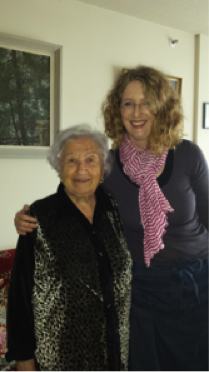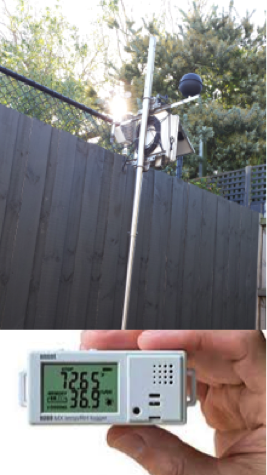Heat vulnerability in Melbourne’s Jewish community

Right: Rachael Bareket PhD Student
The regular summer heatwaves in Australia are an increasing concern for public health. As the temperature and duration of these heatwaves rise, the mortality rates due to heat stress skyrocket. Understanding why some people are more vulnerable than others is vital – many factors can make a person or group of people susceptible to heat stress, and uncovering these details will help improve current emergency services and lead to better design of urban spaces aimed at reducing heat loading.
This is a central focus of the research conducted by the CRC for Water Sensitive Cities (CRCWSC) team as part of The design of the public realm to enhance urban microclimates (Project B3.2). Previous research by the CRCWSC team, led by Professor Nigel Tapper at Monash University, showed that there are distinct heat thresholds above which the mortality rate jumps significantly. “Reducing those temperatures by as little as 2°C will actually save lives,” states Nigel.
The CRCWSC team showed that in Melbourne the mortality rate varied greatly depending on postcode. And while a range of contributing factors leads to this drastic imbalance, Nigel notes that “some community groups in particular are highly vulnerable, and the elderly Jewish migrant community is one of these.”

Temperature measuring equipment
Knowing the specific heat thresholds and the areas where residents are at higher risk gave the CRCWSC team a unique opportunity to study the impacts of heat stress in detail. The Jewish community in Melbourne is relatively self-contained, highly organised, and vulnerable to heat stress – particularly the elderly members not born in Australia – making it the perfect community to work with to understand these effects in detail.
As part of the CRCWSC team, PhD student Rachael Bareket is looking at the habits of the elderly Jewish residents during extreme heat conditions. Each participant is asked to keep a heat diary to record their feelings and actions during these heatwaves. The external and internal heat is also recorded for each residence and correlated to residents’ comfort levels. While the data are still being analysed, the two groups in the study – holocaust survivors, and those originally from the Former Soviet Union – have shown some interesting differences. These results will be vital in the future for implementing heat survival methods and heat adaptation using water sensitive urban design.
Not only do the underlying causes of temperature differences vary, but the comfort levels of individuals can also be affected by many factors: such as the almost invincible mentality of holocaust survivors, or the often strict dress-code of Orthodox Jews. This complexity is part of the reason why such research is vital to fully understand the issues people face during extreme heat. The CRCWSC team found that daily temperatures in residents’ homes varied widely – differences that (along with systematic variations between the two groups) are potentially enough to push individuals over the heat threshold, and increase their risk of death. This result alone highlights the importance of this study for revealing those Melburnians at highest risk, and to help prioritise resources aimed at improving the urban landscape to reduce heat loading on homes.
The research being conducted by the CRCWSC team would not be possible without the help of Jewish Care Victoria. The organisation provides support for Melbourne’s large Jewish community and currently delivers over 20,000 hours of in-home care per month to elderly residents in the community. Stephen Thomas, General Manager Innovation and Quality at Jewish Care, explains that during the particularly bad heatwave in 2009 many elderly residents across Victoria passed away in their homes due to heat stress. He notes “this is just not good enough: that people can be in their homes, not risk assessed, not having the support they need to tolerate periods of heat.”
This past experience, and the approach by the CRCWSC team, led Jewish Care to implement a new policy in 2014 to help people cope better with the heat. This policy, based on the Victorian Government’s Better Health Channel policies, was implemented to great effect last summer; initiatives include “inviting people to attend any of our facilities or day programs so they can come into a cooler environment.”
The research being conducted by the CRCWSC team may still be in its early stages, but it is clear it has already helped the Jewish community, not only in terms of policy changes but also in future development projects. Jewish Care are currently considering the design of their capital developments with regard to shaded areas and green spaces, a project for which CRCWSC research will no doubt provide important details.
While this project is focused on a single ethnic community, both Nigel Tapper and Stephen Thomas agree this research will be easily transferable to any heat-vulnerable community, and the results from this study will save lives during Melbourne’s inevitable summer heatwaves.
Nick Proellocks for the Mind Your Way team
Further reading
Minding the Ethnic Heat-Vulnerability Gap: Identifying Heat Risks in the Ethnic Elderly -
Rachael Bareket’s PhD Poster
Loughnan, M., Nicholls, N. and N. Tapper (2012) “Mapping Heat-Health Risks in Urban Areas.” International Journal of Population Research.
Loughnan, M., Tapper, N., Phan,T. and J. McInnes (2014) “Can a spatial index of heat-related vulnerability predict emergency service demand in Australian capital cities?” International Journal of Emergency Services.
Parliament of Victoria, Standing Committee on Finance and Public Administration (2010) “Report on Department of Health’s January 2009 heatwave in Victoria: an assessment of health impacts”